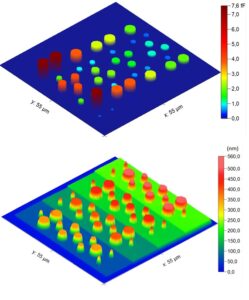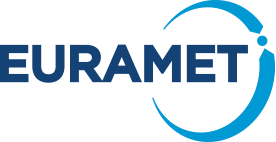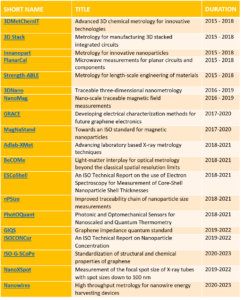
Nanotechnologies and EU metrology landscape
EURAMET is the European Association of National Metrology Institutes (NMIs), created under the EUROMET name in 1987 by EU NMIs, the European Free Trade Association (EFTA) and European Commission (EC). EURAMET acts as the Regional Metrology Organisation (RMO) of Europe, and as such coordinates the cooperation of NMIs in Europe in fields such as research in metrology, traceability of measurements to the SI units, international recognition of national measurement standards and related Calibration and Measurement Capabilities (CMC). Through Knowledge Transfer and cooperation among its members EURAMET facilitates the development of the national metrology infrastructures and ensures an effective use of the resources available in metrology (expertise, infrastructure/facilities).
EURAMET’s mission is to develop and disseminate an integrated, cost-effective and internationally competitive measurement infrastructure for Europe, taking into account the needs of industry, governments and society.
Objectives, organization of the EMPIR program and nanometrology-oriented projects
To implement these objectives, EURAMET is elaborating and executing for more than 10 years European metrology programs as part of EU’s Framework Programs for Research and Technological Development, with the aims to optimize the NMI’s research coordination, to strengthen their collaboration and to encourage collaboration between European NMIs and partners from industry or academia.
EMRP (European Metrology Research Program) was launched in 2009 under Article 169 (EU FP7) as the first EU programme to address metrology issues. EMRP gave the possibility for NMIs to collaborate on research projects dealing with metrology issues on specific topic: industry, energy, environment, health, new technologies, SI units (International System of units) and Scientific excellence in all areas of metrology.
EMPIR (European Metrology Program for Innovation and Research) took over from EMRP in 2014. The emphasis was placed on innovation actions to target industry needs and accelerate uptake of results. Funding has been expanded to research laboratories and industry partners which are not EURAMET’s members, under the same financing rules as for Horizon 2020. New funding opportunities have also been put in place, as with capacity building projects which aim to bridge the gap between EU member states with newly acquired measurement systems and member states with more developed measurement capacities. The EMPIR committee is the decision-making body for all questions concerning the execution of joint research programs. Each member participating in the EMPIR program has a representative and the EMPIR committee’s President is one of the two vice-presidents of EURAMET.
Nanotechnologies, as a field highly concerned by metrology issues, have therefore an important place in the landscape. 19 projects were indeed funded to date by EMPIR on 6 years (the last EMPIR call for proposals is not taken into account here).
Among these 19 Joint Research Projects (JRPs), 5 address metrology issues linked to different standardization needs expressed by Technical Committees from CEN (European Committee for Standardization) or ISO (International Organization for Standardization):
- nPSize: « Improved traceability chain of nanoparticle size measurements», aims to improve nanoparticles size measurements, for evaluation of their risks for health. It is a 3-years project which started in 2018 within the framework of CEN/TC 352 ‘Nanotechnologies’, ISO/TC 229 ‘Nanotechnologies’, ISO/TC 24/SC 4 ‘Particle characterization’ and ISO/TC 201/SC 9 ‘Scanning probe microscopy’.
- MagNaStand: « Towards an ISO standard for magnetic nanoparticles », is mant to develop new measurement approaches to characterize magnetic nanoparticles and spur innovation. The project started in 2017 for 3 years. It will lead to the development of ISO 19807 standard “Liquid suspensions of magnetic nanoparticles” by ISO/TC229 WG4.
- NanoXSpot: « Measurement of the focal spot size of X-ray tubes with spot sizes down to 100 nm » is meant to enable component inspection to the nanometer scale. It is a 3-years project that started on 2019, and is related to the preparation of prenormative documents for submission to CEN/TC 138 ‘Non-destructive testing’ and to revise standards in the EN 12543 series for focal spot measurements as well as to harmonize standards and measurement methods between CEN, ISO, and ASTM.
- GRACE: « Developing electrical characterisation methods for future graphene electronics », started in 2017 for 3 years. It aims to develop new methods for electrical characterisation of graphene. The project will contribute to standards development work within IEC/TC113 ‘Nanotechnology for electrotechnical products and systems’.
- ISO-G-SCoPe: « Standardisation of structural and chemical properties of graphene », started in 2020 for 3 years. Its objective is to underpin the quality of graphene produced by developing the procedures needed to reliably characterize the structural properties (thickness and lateral dimensions of flakes) and chemical properties of graphene, graphene oxide and functionalized graphene (N-, O- and F-). This work will provide input for several documents currently being developed within international standardization: ISO TS 21356-1 ‘Structural characterisation of graphene: Part 1: Graphene from powders and liquid dispersions‘, ISO/PWI 23359 ‘Chemical characterisation for graphene in powders and suspensions‘ & ISO/PWI 23879 ‘Structural characterisation of graphene oxide flakes: thickness and lateral size measurement using SEM and AFM‘.
Those projects are in relation with 5 different standardization Technical Committees, about different topics: health, electronics, materials and instrumentation. Around 25 industrial partners and 10 NMI or Designated Institutes (DIs) are involved in: BAM (DE), CEM (ES), INRIM (IT), LGC (UK), LNE (FR), METAS (CH), NPL (UK), PTB (DE), SMD (BE), VSL (NL) and VTT (FI).
Four other projects have been funded to support SI development through R&D in fundamental and applied sciences of measurement. The topics are related to dimensional and electrical metrological measurements:
- 3DNano: « Traceable three-dimensional nanometrology », started in 2016. The aim was to develop metrology for accurate and traceable nanoscale 3D measurement.
- NanoMag: « Nano-scale traceable magnetic field measurements » started in 2016. The project led to accurate and traceable measurement capabilities for micro and nanoscale magnetic field measurement.
- PhotOQuant: « Photonic and Optomechanical Sensors for Nanoscaled and Quantum Thermometry» aims at developing photonic and optomechanical sensors for nanometric and quantum thermometry. The optomechanical sensors developed could be used as a future primary quantum standard for temperature measurement.
- GIQS: « Graphene impedance quantum standard » started in 2019. The aim is to establish SI linked quantum traceability by exploiting the potential of graphene.
On these three projects, 6 industrial partners and 13 NMIs are involved: CMI (CZ), DFM (DK), INRIM (IT), LNE (FR), METAS (CH), NPL (UK), PTB (DE), RISE (SE), SMD (BE), TÜBITAK (TR), UME (TR), VSL (NL) and VTT (FI).
Seven projects aim (or aimed) at developing or improving measurement methods in support of nanofabrication and performances/quality control:
- 3DMetChemIT: « Advanced 3D chemical metrology for innovative technologies » addresses major challenges in the analysis of buried interfaces and heterogeneous organic-inorganic materials to develop beyond state-of-the-art capabilities, trusted methods and reference materials for 3D-resolved chemical analysis using secondary ion mass spectrometry, atom probe tomography and grazing-incidence x-ray fluorescence spectroscopy. It was a 3-years project that ended in 2018.
- 3D Stack: « Metrology for manufacturing 3D stacked integrated circuits » delivered traceable metrological infrastructure required for structural and chemical defects inspection in high aspect ratio through silicon vias (HAR TSV) and wafer/chip bonding and thinning. The 3-years project also ended in 2018.
- Nanowires: « High throughput metrology for nanowire energy harvesting devices » aims at contributing to the development of renewable energies through the designing of new measurement methods needed to better understand the performance of energy recovery devices based on vertical nanowires. The project started in 2020.
- PlanarCal: « Microwave measurements for planar circuits and components » ended in 2018. The project enabled the traceable measurement and characterisation of integrated circuits and components from radio-frequency to sub-mm frequencies allowing industry to characterise components and devices for eventual use in high-speed and microwave applications (e.g. wireless communications, automotive radar and medical sensing) with known measurement uncertainties.
- BeCOMe: « Light-matter interplay for optical metrology beyond the classical spatial resolution limits» will aim at developing new optical measurement techniques for the investigation of structures at the nanoscale, with traceable spatial resolution beyond classical limits and sub-nanometre accuracy.
- Innanopart « Metrology for innovative nanoparticles», which ended in 2018, aimed at measuring the concentration of nanoparticles (in particular for non-spherical particles of which importance in innovative applications is growing) and define their surface chemistry, as part of the industrial manufacture of these
- Strength-ABLE « Metrology for length-scale engineering of materials » helped to improve the understanding of the material-strength mechanisms and to demonstrate the material and component performance benefits that length-scale engineering offers.

The EMPIR program also makes it possible to increase the impact of European projects through dissemination and results exploitation activities. In this context, the ISOCONCur (« An ISO Technical Report on Nanoparticle Concentration ») and ESCoShell (« An ISO Technical Report on the use of Electron Spectroscopy for Measurement of Core-Shell Nanoparticle Shell Thicknesses ») projects followed on from the EMPIR Innanopart project (described above) and the BioSurf project funded by the previous program EMRP, respectively. The latter has made it possible to develop methods for reliably and consistently measuring the performance of nanoparticles-enhanced biochemical interfaces used in in vitro diagnostic devices. The project Adlab-XMet (« Advancing laboratory based X-ray metrology techniques ») started in 2018. It follows the EMRP project TReND, which developed non-destructive X-ray analysis procedures and calibration samples to accurately characterize electrical and chemical properties of nanostructured devices.
The table below summarizes the different EU nano-related projects:
(click table to enlarge)
EMN and EPM
The European Partnership on Metrology (EPM) will take over from EMPIR within the framework of the Horizon Europe program. EPM will be more open than its predecessors on external cooperation (academic, university, international) and the emphasis will be on knowledge sharing and broad partnership, open to business, so as to promote innovation and competitiveness of European industry.
The experience of previous programs (EMRP and EMPIR) has shown the need to develop mechanisms to create a more strategic and long-term cooperation between a wider community of metrology experts, researchers and end users (industry, government agencies…). Thus, European Metrology Networks (EMNs) were initiated from the end of the EMPIR program and will be further developed within EPM with the aim to analyze and respond to European and global metrology needs in a coordinated and sustainable way. These EMNs also make it possible to define common metrology strategies including aspects such as research, infrastructure, knowledge transfer and services and the corresponding infrastructures will continue engagement and cooperation for as long as the need remains.
Until now, two EMN potentially interesting for the nanotechnologies/nanomaterials community were launched:
– AdvManuNet « Support for a European Metrology Network on advanced manufacturing » ;
– Quantum « EMN for Quantum Technologies ».
AdvManuNet will increase the input of the metrology community in the field of advanced manufacturing (in particular at the nanoscale with thin films characterization for example), while Quantum deals with Quantum Technologies in view to insure the needed levels of standardization and reliability to support progress in research and development on those promising and strategical technologies for EU.
This framework of European Metrology Networks can be a good opportunity to support the development of sustainable nanomanufacturing and current initiatives in the field (e.g. EUROnanoLAB, GO NANOFAB, ETPN…) by bringing together the various expertise and resources/infrastructures in EU metrology essential to the cross-disciplinary nature of the nanotechnologies field.
Authors: Diane Gumuchian & Georges Favre, LNE Nanotech Institute



